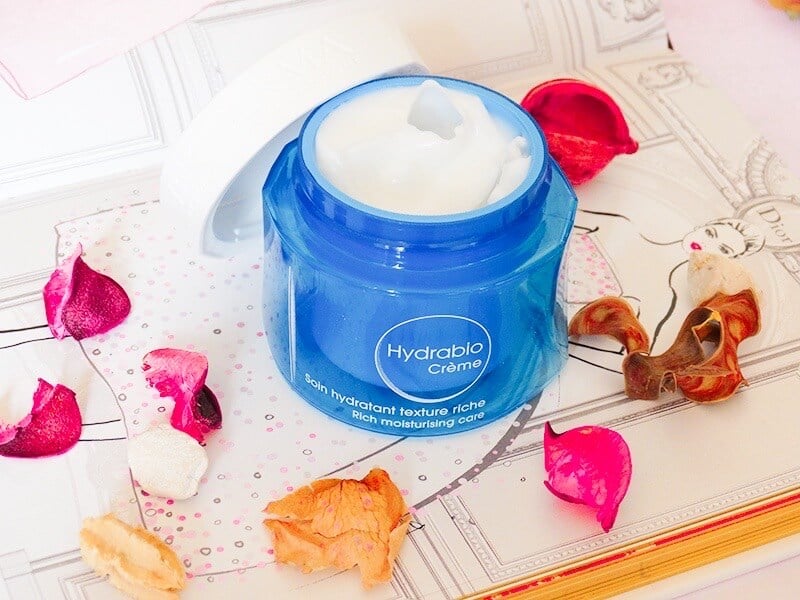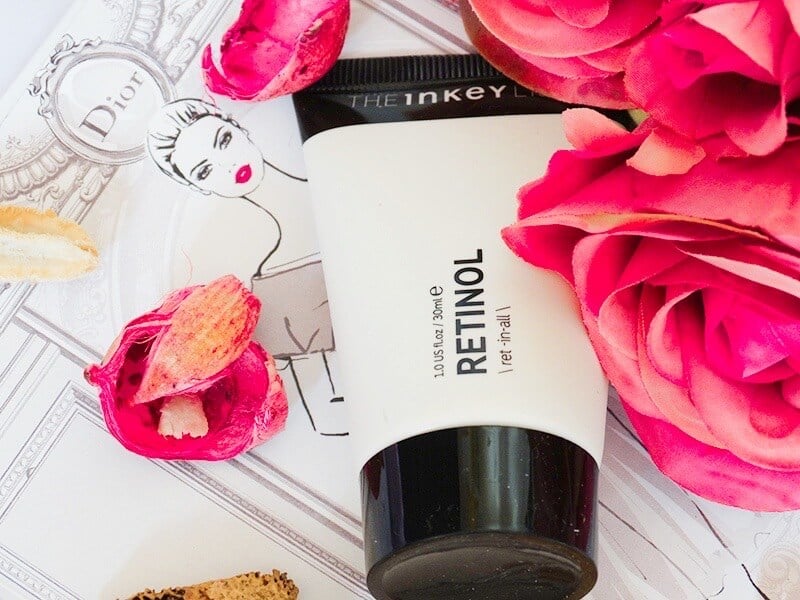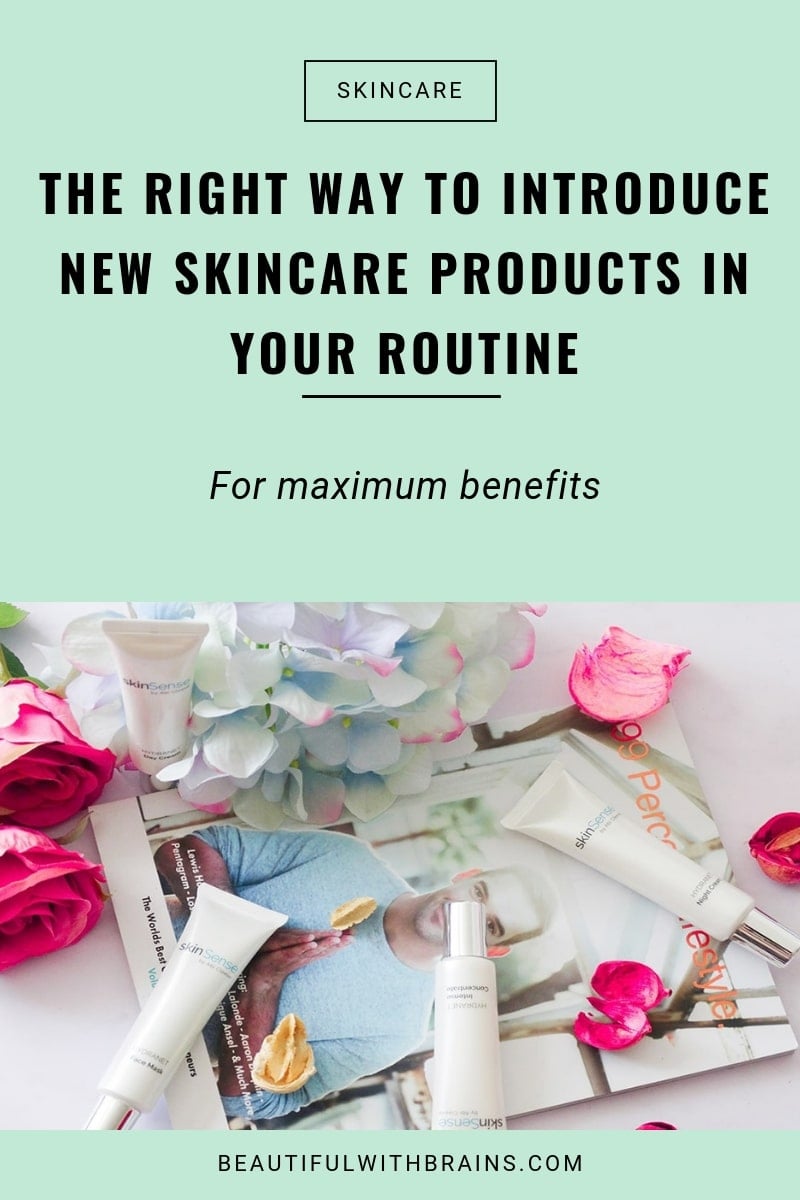Ever wondered how to introduce new products into your skincare routine? I love trying new makeup products all the time. It’s so much fun! But, skincare products? That’s a different story.
If a lipstick shade doesn’t suit you, you can wipe it off. But if your moisturiser isn’t working? You could get a breakout. Or an irritation.
Sticking to your tried and tested staples is safer. But, sometimes you just want to try something new.
Maybe your HG was discontinued. Maybe you keep hearing raves about a new serum and want to see what the hype is all about. Or maybe your skin has changed and you need to come up with a whole new routine.
Whatever the reason, how can you introduce new skincare products in your routine without the risk of breakouts, irritations and co? Here are a few tips to help you out:
1. Choose new skincare products wisely
Picking a random serum or cream from the shelf is a recipe for disaster. How can you give your skin what it needs when you don’t even know what it needs?!
The first step is to figure out your skin type and concerns. Is your skin oily and breaking out all the time? Or dry and mired with dark spots? Or it’s pretty normal and you just want to get started with anti-aging?
Once you know what you’re dealing with, you can look for products targeted for your skin type and needs.
Just don’t trust labels! Do you know how many moisturisers with oily skin are loaded with comedogenic ingredients that give you pimples, for example?
Always check the ingredient list to make sure the product has actives that can do the job and nothing that can make things worse.
Don’t know what to look for? Check out this post to know what each skin type needs (and doesn’t!).
WHAT INGREDIENTS SHOULD I AVOID FOR ACNE-PRONE SKIN?
If your skin breaks out at the slightest provocation, stay far, far away from comedogenic ingredients. These are the sneaky little devils that clog pores and trigger breakouts. Some common offenders? Coconut oil (yep, even though it’s amazing for hair and body, it’s too rich for acne-prone skin), isopropyl myristate (often found in primers and heavy creams), and mineral oil (a common culprit in thick, occlusive formulas). If you see these lurking on the label, keep walking.
WHAT’S THE BEST ANTI-AGING INGREDIENT?
If you’re on the hunt for firmer, plumper skin with fewer fine lines, look no further than retinol. This vitamin A derivative speeds up cell turnover, boosts collagen, and smooths wrinkles. Let’s not forget vitamin C, which brightens, fights free radicals, and helps with hyperpigmentation. Use them wisely, and you’ll be aging like fine wine.
CAN I USE THE SAME PRODUCT FOR MORNING AND NIGHT?
Some products are multitaskers, but others need to be used at the right time. Sunscreen? Daytime only (unless you enjoy wearing SPF to bed for no reason). Retinol? Strictly a nighttime affair unless you want to risk sun sensitivity. Gentle moisturizers and hydrating serums? Go ahead and use them twice a day, no problem.
Related: How To Determine Your Skin Type (+ Free Test!)
Want to get the most out of your skincare products? Click on the image below to subscribe to my newsletter and receive the “How To Combine Actives Like A Pro” cheatsheet.
2. Read Reviews
You don’t have to be a guinea pig. Lots of other people have already tried the products you’re interested in and shared their opinion online. Here are the best places to find them:
- Makeup Alley: You can filter reviews based on age and skin type so you can get a more accurate idea of what it can do for you, too.
- Reddit (r/SkincareAddiction): Want brutally honest reviews? This is where skincare lovers spill the tea. You’ll find real experiences, before-and-after pictures, and solid advice. Just keep in mind—what works for someone else might not work for you, so always take individual results with a grain of salt.
- Blogs: Finding a good skincare blogger you trust and understands skincare is like finding a best friend you can turn to for advice whenever you need it. Just make sure they can understand the science of skincare. Bonus points if they’re dealing with your same skin type and concerns. You can find my fave skincare bloggers here.
Pro Tip: If every single review is glowing with no cons mentioned? Be skeptical. Not all influencers disclose sponsorships, and some brands are known for deleting bad reviews.
Related: 8 Best Science-Based Skincare Blogs
3. Try Samples
Ok, so all the reviews are good and you really, really, really want to try that cream. But… it’s not exactly cheap, and you’d like to take it for a test drive first.
Go to the cosmetic counter and ask for a sample. Just make sure they don’t give you one of those tiny sachets samples.
Those can tell if you like the texture or if the product will irritate your skin BUT NOT if it does what it claims. You need to use a product for roughly a month before you can see a difference (or not).
What if the SA doesn’t want to give you a sample? Complain to the manager or walk away. They obviously don’t want your money, so give it to someone else who appreciates you and is willing to help you.
Related: How Long Does It Take For Skincare Products To Work?

4. Do A Patch Test
Ok, so now you got your sample. Don’t slather the cream all over your face, yet. If something in there doesn’t agree with your skin, you may end up with a red and itchy rash all over your face. The horror!
Instead, do a patch test. Apply a small amount on a tiny area, like your wrist, and watch what happens for the next 24 hours.
Here’s what to look out for:
- No reaction? All good. Go ahead and use it on your face.
- Mild redness or tingling? Could be an adjustment period, but proceed with caution.
- Burning, itching, swelling, or breakout? Immediate red flag. Wash it off and toss the product. Your skin wants nothing to do with it.
Some ingredients, like retinol or exfoliating acids, can cause an initial purge. But irritation is different from purging, so don’t ignore your skin’s SOS signals!
Related: How To Do A Skin Patch Test
5. Try One Product At A Time
Ok, so you got a new skincare set, or went a bit overboard at Sephora and came home with a big skincare haul. Good for you. Just don’t use all your new skincare products at once.
I know it’s tempting, and you’re itching to see what miracles they can do for your skin. But, what if one of them irritates your skin or you end up with pimples all over your face?
If you introduced several products in your skincare routine the very same day, how are you gonna know which one is the culprit?
The trick? Introduce one new product at a time. And by one at a time, I mean waiting at least 2-3 weeks before adding something else. I know that sounds like an eternity, but it’s the only way to figure out if a product is actually working for you.
Here’s why the wait is worth it:
- Irritations show up fast: If a product stings, burns, or dries out your skin, you’ll notice within a few days.
- Breakouts can take time: If a product is clogging your pores, it might take a couple of weeks for pimples to surface.
- You’ll know what works: If you’re using five new things at once, how do you know which one is actually making your skin glow?
This is especially important if you’re adding strong actives (like retinol or acids) to your routine. Patience = happy skin.
Related: How Long Does It Take Skincare Products To Work?

6. Try New Products On Alternate Days
This applies only to products with strong active ingredients—think retinoids, glycolic acid, salicylic acid, benzoyl peroxide, and even vitamin C. These ingredients are amazing for your skin, but they also require a slow introduction.
If you dive in headfirst and use them every day from the start, your skin will freak out. Think peeling, redness, irritation, or even a full-blown skin barrier meltdown. To avoid this, start slow:
- Use the new active every other night for the first couple of weeks.
- If your skin is tolerating it well, you can gradually increase to daily use.
- If you notice dryness or irritation, scale back and add a good moisturizer to help buffer the effects.
Some actives also don’t play well together. For example, retinol and glycolic acid? Too harsh together. Do your research before layering!
Related: The Complete Guide To Glycolic Acid: What It Is, What It Does And How To Use It
7. Don’t try new products before important events
I know, I know. You just bought a new brightening mask and want to glow for your best friend’s wedding. But what if it backfires? One wrong product and you could end up with an angry, red rash right before your big event. Yikes.
If you have an important event coming up (wedding, graduation, date night, photoshoot , whatever), stick to your tried-and-true routine. The last thing you need is a last-minute skincare disaster.
If you must try something new, do it at least a month in advance. That way, if something goes wrong, your skin has plenty of time to recover.
And if you wake up with a reaction right before your event? Ice packs, antihistamines, and soothing creams (like aloe vera or Centella Asiatica) can help calm things down. But honestly, prevention is better than cure. Don’t risk it!
The Bottom Line
Trying new skincare products is exciting, but it doesn’t have to be a gamble. Take your time, do your research, and introduce products the right way. Your skin will thank you!


This is very useful 😀
thanks!
Celeste, you’re welcome and I’m glad you enjoyed the post. 🙂
I totally agree with all of these tips (although I admit I don’t really do patch tests)! I only try one new product at a time so that I can evaluate it properly, and see if it causes me to breakout, but it takes a lot of patience to just try one thing at once! Lately I’ve been trying hair loss and eyebrow products, and it takes months and months to see results, so the waiting part is so hard. And I love Makeupalley and Beautypedia too.
Jeni, trying only one thing at a time is the worst part for me too but it has to be done. I’ve just both a Clarins travel kit and I’m itching to try all the products but last time I tried all the products in a set at once I got a bad breakouts and it took me ages to figure out which one was the culprit. I’ve learned my lesson but patience is not one of my virtues lol.
Tip #7 is like a mantra to me!!! Sometimes, it takes me so long to try out a new product because I keep on postponing because of some important events coming up.
I rarely have problem with new products, but it’s always good to be more cautious! 🙂
Vonvon, I agree. Even if one has skin that doesn’t get easily irritated, it’s always best to err on the safe side of caution and postponing trying new products till after an important event. You never know when your skin will react badly. 🙂
hello i am currently using “LA ROCHE POSAY Anthelios SX Daily Moisturizer Mexoryl spf 15” sunscreen since i have oily skin can you tell me another sunscreen like that since this cream is very expensive
thanks
Somasam, you can check out my favourite sunscreens for oily skin here: http://beautifulwithbrains.com/2013/05/07/what-are-the-best-sunscreens-for-oily-skin/
Hi, I’ve been wanting to try this new skin cleanser that I’ve bought. How long should i wait before i start using it? It’s currently evening and I should be using my old facial cleanser tonight before bed since I’ve used the old one this morning. Should i wait a day? Or I can start using it tomorrow morning?(given that the spot test is all good on my skin)
Harry, I always recommend to wait at least 3 weeks before using a new products. If you haven’t used anything new for the past 3 weeks, you can introduce it straight away.
Hi, I’m a little bit confused about trying one product at a time. Does it mean that if I used a new product and it actually works fine for me and sees the results in 3 weeks. And I decided to add another product, do I need to use it with the product that works for me or should I use it separately for another 3 weeks? Thanks.
Dana, I meant trying one NEW product at a time. If you buy two new products, for example, add only ONE to your existing skincare routine. After 3 weeks, if everything is fine, you can keep using that product together with the rest of your skincare routine, and add the second one.